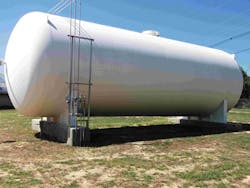Albertville, Ala., is a small city on Sand Mountain, a 26-sq-mile plateau in the northeast corner of the state. The Municipal Utilities Board (MUB) of Albertville operates the MUB wastewater treatment plant (WWTP), an 11.5-mgd facility that serves approximately 20,000 residential and industrial customers in Albertville and the surrounding areas.
The Problem
As part of an ongoing effort to improve efficiency and lifecycle costs across all of its projects, the MUB set out to upgrade solids handling at the WWTP and pursue Class-A biosolids certification, a U.S. Environmental Protection Agency (EPA) designation for dewatered and heated sludge that contains low levels of pathogens. Since Class-A biosolids meet EPA guidelines for land application with no restrictions, they can be sold for use as fertilizer or compost for farms and vegetable gardens.
The plant has anaerobic digesters with a biogas recovery system, which allows the facility to use the biogas that is rich in methane as a fuel source for the sludge dryer. Plant operators selected new dryer technology for sludge treatment and used multiple sludge-to-water heat exchangers to recover heat and squeeze as much energy as possible out of the system. The facility, which sees an average demand of approximately 7.5 mgd, sometimes powered its boilers with methane gas captured from its anaerobic digesters, but during off-peak times, operators relied on natural gas as a secondary fuel to supplement the recovered methane gas.
“We had purchased a dryer, and we were looking to reduce our operating costs by increasing our use of biogas to run our boilers,” said Dale Williams, plant manager at the Albertville MUB WWTP. “In the past, we had enough pressure on the gas system during the summer months to power the boilers, but we would need to swap over to natural gas during our low-demand times in the colder months.”
To fuel the boilers solely with biogas and eliminate the need to purchase natural gas, operators looked for a way to compress and store the extra gas produced in the anaerobic digesters during peak operation. With the help of Krebs Eng. Inc., the Albertville MUB evaluated different blower manufacturers to identify one that could supply a biogas blower to reliably compress the excess gas produced at peak times and deliver it to a storage tank for later use.
The Solution
Following a standard request for proposal process, Albertville selected a 30-hp Aerzen Biogas Delta Blower package GM 10 S to compress the methane-rich biogas into the holding tank.
“MUB had already run Aerzen equipment in other parts of its facility for decades, so there was a comfort level that it would run and run well,” said Holman Waters of The TDH Co., the sales representative for Aerzen blowers in Alabama, Tennessee, Georgia and the Florida Panhandle. “When the plant learned that Aerzen could supply a biogas blower, their engineers completed a technological review to ensure the Aerzen equipment was qualified for the application.” It qualified, and once the bid process was complete, Aerzen was selected for the project.
Designed for landfill, biogas and natural gas applications, the Biogas Delta GM 10 S is a positive displacement blower that is built for safety. At the Albertville facility, the blower takes any biogas—including methane gas not being directed to the dryers—compresses it to 14 psi and sends it to the storage vessel; the biogas is not treated and is stored in gasholder covers on the anaerobic digesters. Excess biogas is routed to the blower and compressed to 14 psi for storage. The outlet pressure (14 psi) is the basis of controlling the blower; the inlet pressure is very low, usually 8 in. to 12 in. WC.
Based on the same sound engineering and precision machining as Aerzen’s three-lobe positive displacement blowers for conventional applications, Delta biogas blowers are available in ten package sizes covering intake volume flows of 35 inlet cu ft/minute (icfm) up to 1,500 icfm, and positive pressure up to 15 psig. For the biogas application, the blower stage features a gastight driveshaft seal and no absorption materials in the discharge silencer. The ductile iron casing stage, inlet and discharge silencers are TÜV-certified and explosion-proof up to 174 psig.
The blower was shipped completely assembled, so it required no extensive installation work, grouting or special anchoring. A swing plate attached to the base provides automatic tensioning of the blower belts, using the mass of the motor to maintain tension with no need for adjustments or springs. This feature of the Delta blower not only reduces maintenance requirements, but also reduces the potential for damaging belts or bearings by operating with too little or too much belt tension.
The Results
In the 18 months since its installation at the MUB WWTP, the Delta blower has run smoothly with no problems or interruptions.
“Since we’ve had the biogas blower installed, we’re able to maintain a constant pressure on the gas system to ensure that we never switch over to natural gas,” Williams said. “On the digester side, we’re now able to feed 100% biogas all year ‘round.”
The biogas blower’s reliable operation allows the Albertville MUB to meet its goal of reducing operational costs by producing its own power at a cost lower than retail energy sources. The utility has also improved its environmental footprint, reducing greenhouse gas emissions and cutting back on overall energy consumption by powering its equipment with a renewable fuel that would otherwise have been flared off as a waste product.
